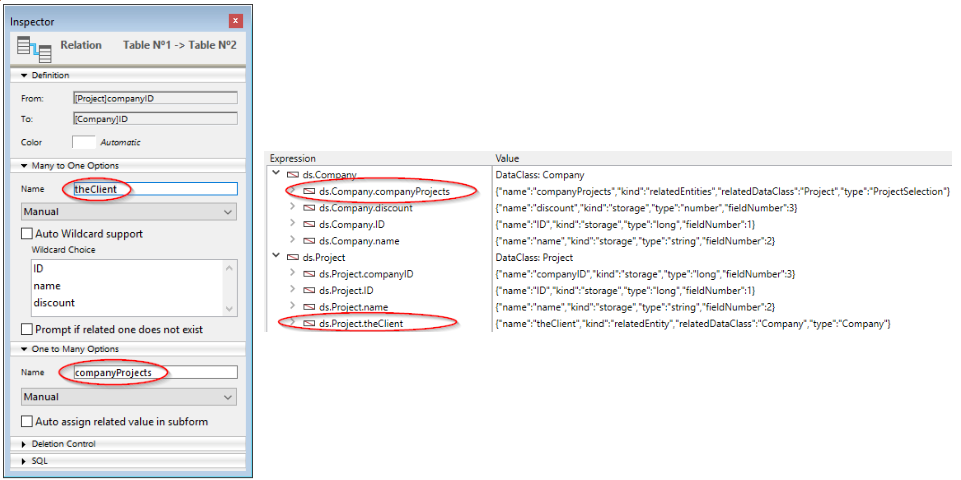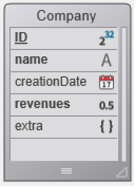Objetos Data Model
The ORDA technology is based upon an automatic mapping of an underlying 4D structure. Também fornece acesso aos dados através de objetos seleção de entidades (entity selection) e entidades (entity). Como resultado, ORDA expõe toda a base de dados como um conjunto de objetos de modelo de dados.
Mapeamento da estrutura
When you call a datastore using the ds or the Open datastore command, 4D automatically references tables and fields of the corresponding 4D structure as properties of the returned datastore object:
- As tabelas correspondem às dataclasses.
- Os campos são mapeados para atributos de armazenamento.
- Relations are mapped to relation attributes - relation names, defined in the Structure editor, are used as relation attribute names.

Regras gerais
As seguintes regras são aplicadas a quaisquer conversões:
- Os nomes de tabelas, campos e relações são mapeados para nomes de propriedade de objeto. Asegúrese de que dichos nombres cumplen con las reglas generales de denominación de objetos, como se explica en la sección Convenciones de denominación de objetos.
- Uma datastore só referencia as tabelas com uma única chave primária. As tabelas seguintes não são referenciadas:
- Tabelas sem chave primária
- Tabelas com chaves primárias compostas.
- Los campos BLOB están disponibles automáticamente como atributos del tipo objeto Blob.
O mapeamento ORDA não leva em consideração:
- a opção "Invisível" para tabelas ou campos,
- the virtual structure defined through
SET TABLE TITLESorSET FIELD TITLES,- a propriedade "Manual" ou "Automática" das relações.
Regras para o controlo do acesso remoto
Cuando se accede a un datastore remoto a través del comando Abrir datastore o peticiones REST, sólo las tablas y los campos con la propiedad Exponer como recurso REST están disponibles de forma remota.
This option must be selected at the 4D structure level for each table and each field that you want to be exposed as dataclass and attribute in the datastore:

Actualização do modelo de dados
Any modifications applied at the level of the database structure invalidate the current ORDA model layer. Estas modificações incluem:
- adicionar ou remover uma tabela, um campo ou uma relação
- renomeação de uma tabela, um campo ou uma relação
- changing a core property of a field (type, unique, index, autoincrement, null value support)
Cuando la capa actual del modelo ORDA ha sido invalidada, es automáticamente recargada y actualizada en llamadas posteriores del datastore local ds en 4D y 4D Server. Note that existing references to ORDA objects such as entities or entity selections will continue to use the model from which they have been created, until they are regenerated.
However, the updated ORDA model layer is not automatically available in the following contexts:
- a remote 4D application connected to 4D Server -- the remote application must reconnect to the server.
- un datastore remoto abierto mediante
Open datastoreo a través de llamadas REST -- debe abrirse una nueva sesión.
Definição de objetos
Datastore
O datastore é o objeto de interface para um banco de dados. Constrói uma representação de todo o banco de dados como objeto. Un datastore está formado por un modelo y datos:
- The model contains and describes all the dataclasses that make up the datastore. É independente do próprio banco de dados subjacente.
- Os dados referem-se à informação que vai ser utilizada e armazenada neste modelo. For example, names, addresses, and birthdates of employees are pieces of data that you can work with in a datastore.
Cuando se maneja a través del código, el datastore es un objeto cuyas propiedades son todas las dataclasses que se han expuesto específicamente.
4D permite lidar com os seguintes datastores:
- el datastore local, basado en la base 4D actual, devuelta por el comando
ds(el datastore principal). - uno o más datastores remotos expuestos como recursos REST en las bases 4D remotas, devueltos por el comando
Open datastore.
Um datastore faz referência apenas a um único banco de dados local ou remoto.
O próprio objeto datastore não pode ser copiado como um objeto:
$mydatastore:=OB Copy(ds) //retorna nulo
No entanto, as propriedades do datastore são enumeráveis:
ARRAY TEXT($prop;0)
OB GET PROPERTY NAMES(ds;$prop)
//$prop contém os nomes de todas as classes de dados
El datastore principal (por defecto) siempre está disponible a través del comando ds, pero el comando Open datastore permite hacer referencia a todo datastore remoto.
Dataclass
Uma dataclass é o equivalente a uma tabela. It is used as an object model and references all fields as attributes, including relational attributes (attributes built upon relations between dataclasses). Os atributos relacionais podem ser utilizados em consultas como qualquer outro atributo.
Todas las dataclasses de un proyecto 4D están disponibles como propiedad del datastore ds. For remote datastores accessed through Open datastore or REST requests, the Expose as REST resource option must be selected at the 4D structure level for each exposed table that you want to be exposed as dataclass in the datastore.
Por exemplo, considere a seguinte tabela na estrutura 4D:

La tabla Company está disponible automáticamente como dataclass en el datastore ds. Você pode escrever:
var $compClass : cs. Company //declares a $compClass object variable of the Company class
$compClass:=ds. Company //assigns the Company dataclass reference to $compClass
Um objeto de classe de dados pode conter:
- attributes
- atributos relacionais
The dataclass offers an abstraction of the physical database and allows handling a conceptual data model. A dataclass é a única forma de consultar o datastore. Uma consulta é feita a partir de uma única dataclass. As consultas são construídas em torno de atributos e nomes de atributos de relação das dataclasses. Assim, os atributos de relação são o meio de envolver várias tabelas ligadas numa consulta.
O próprio objeto dataclass não pode ser copiado como um objeto:
$mydataclass:=OB Copy(ds. Employee) //returns null
No entanto, as propriedades da dataclass são enumeráveis:
ARRAY TEXT($prop;0)
OB GET PROPERTY NAMES(ds. Employee;$prop)
//$prop contains the names of all the dataclasse attributes
Atributo
Dataclass properties are attribute objects describing the underlying fields or relations. Por exemplo:
$nameAttribute:=ds. Company.name //reference to class attribute
$revenuesAttribute:=ds. Company["revenues"] //alternate way
Este código asigna a $nameAttribute y $revenuesAttribute las referencias a los atributos name y revenues de la clase Company. Essa sintaxe NAO devolve valores mantidos dentro do atributo, mas sim devolve referências aos próprios atributos. Para manejar los valores, es necesario pasar por Entidades.
Todos los campos elegibles de una tabla están disponibles como atributos de su dataclass padre. Para los datastores remotos a los que se accede a través de Open datastore o peticiones REST, se debe seleccionar la opción Exponer como recurso REST al nivel de la estructura 4D para cada campo que se desee exponer como at
Atributos de armazenamento e de relação
Atributos da Dataclass vêm em vários tipos: armazenamento, relatedEntity e relatedEntities. Los atributos escalares (es decir, ofrecen un único valor) soportan todos los tipos de datos estándar 4D (entero, texto, objeto, etc.).
- Un atributo de almacenamiento equivale a un campo en la base de datos 4D y puede indexarse. Values assigned to a storage attribute are stored as part of the entity when it is saved. When a storage attribute is accessed, its value comes directly from the datastore. Storage attributes are the most basic building block of an entity and are defined by name and data type.
- Un atributo relacional ofrece acceso a otras entidades. Os atributos relação podem resultar em uma única entidade (ou nenhuma entidade) ou em uma seleção de entidades (de 0 a N). Relation attributes are built upon "classic" relations in the relational structure to provide direct access to related entity or related entities. Os atributos de relação estão diretamente disponíveis no ORDA usando seus nomes.
For example, consider the following partial database structure and the relation properties:

Todos os atributos de armazenamento estarão automaticamente disponíveis:
- na dataclass Project: "ID", "name" e "companyID"
- na dataclass Company: "ID", "name" e "discount"
In addition, the following relation attributes will also be automatically available:
- en la dataclass Project: el atributo theClient, del tipo "relatedEntity"; hay como máximo una Empresa para cada Proyecto (el cliente)
- en la dataclass Company: el atributo companyProjects, del tipo "relatedEntities"; para cada empresa existe un cierto número de proyectos relacionados.
> > The Manual or Automatic property of a database relation has no effect in ORDA.
Todos os atributos da dataclass são expostos como propriedades da dataclass:

Keep in mind that these objects describe attributes, but do not give access to data. La lectura o escritura de los datos se realiza a través de los objetos entidad.
Atributos computados e alias
Los atributos calculados y alias son atributos "virtuales". O seu valor não é armazenado, mas avaliado sempre que são acedidos. They do not belong to the underlying database structure, but are built upon it and can be used as any attribute of the data model.
Entity
Uma entidade é o equivalente a um registo. Na verdade, é um objeto que referir-se a um registo no banco de dados. Puede verse como una instancia de una dataclass, como un registro de la tabla correspondiente a la dataclass. However, an entity also contains data correlated to the database related to the datastore.
O objetivo da entidade é gerir dados (criar, atualizar, apagar). When an entity reference is obtained by means of an entity selection, it also retains information about the entity selection which allows iteration through the selection.
O objeto entidade em si não pode ser copiado como um objeto:
$myentity:=OB Copy(ds. Employee.get(1)) //retorna null
As propriedades da entidade são, no entanto, enumeráveis:
ARRAY TEXT($prop;0)
OB GET PROPERTY NAMES(ds. Employee.get(1);$prop)
//$prop contains the names of all the entity attributes
Seleção de entidades
Uma seleção de entidade é um objeto contendo uma ou mais referência(s) a entidades pertencentes à mesma dataclass. É normalmente criado como resultado de uma consulta ou devolvido a partir de um atributo de relação. Uma seleção de entidades pode conter 0, 1 ou X entidades da dataclass -- onde X pode representar o número total de entidades contidas na dataclass.
Exemplo:
var $e : cs. EmployeeSelection //declares a $e object variable of the EmployeeSelection class type
$e:=ds. Employee.all() //assigns the resulting entity selection reference to the $e variable
Las entity selections pueden estar "ordenadas" o "sin ordenar" (ver abajo).
Las entity selections también pueden ser "compartibles" o "no compartibles", dependiendo de cómo se hayan creado.
O próprio objeto de seleção de entidades não pode ser copiado como um objeto:
$myentitysel:=OB Copy(ds. Employee.all()) //returns null
No entanto, as propriedades de seleção de entidades são enumeráveis:
ARRAY TEXT($prop;0)
OB GET PROPERTY NAMES(ds. Employee.all();$prop)
//$prop contains the names of the entity selection properties
//("length", 00", "01"...)
Entity selections ordenadas ou não ordenadas
Por razones de optimización, por defecto, 4D ORDA normalmente crea selecciones de entidades no ordenadas, excepto cuando utiliza el método orderBy( ) o utiliza opciones específicas. In this documentation, unless specified, "entity selection" usually refers to an "unordered entity selection".
Ordered entity selections are created only when necessary or when specifically requested using options, i.e. in the following cases:
- resultado de un
orderBy()sobre una selección (de cualquier tipo) o de unorderBy()sobre una dataclass - resultado del método
newSelection()con la opcióndk keep ordered
As selecções de entidades não ordenadas são criadas nos seguintes casos:
- resultado de un
query()estándar sobre una selección (de cualquier tipo) o de unquery()sobre una dataclass, - resultado del método
newSelection()sin opción, - resultado de uno de los métodos de comparación, sean cuales sean los tipos de selección de entrada:
or(),and(),minus().
Las siguientes selecciones de entidades son siempre ordenadas:
- > > * > > * entity selections returned by 4D Server to a remote client > * entity selections built upon remote datastores.
- selecções de entidades construídas em datastores remotos.
Note that when an ordered entity selection becomes an unordered entity selection, any repeated entity references are removed.